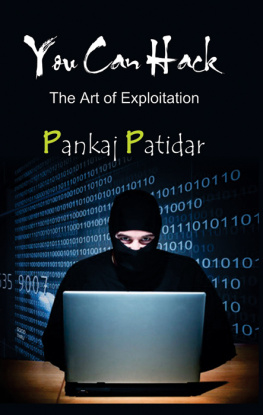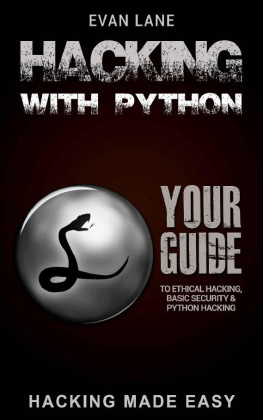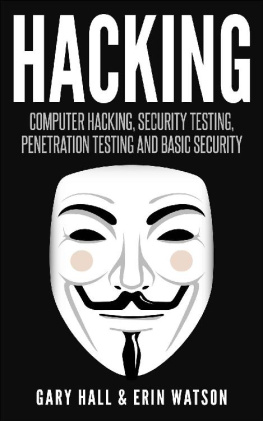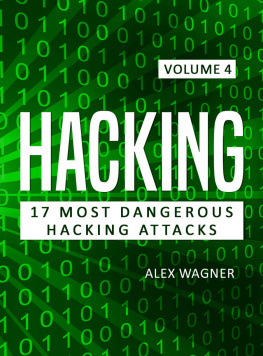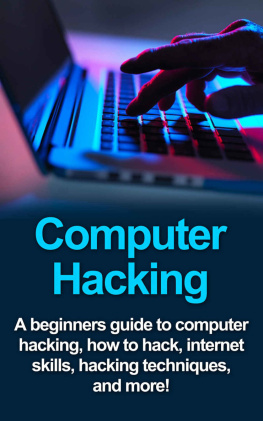DEDICATED TO:-
MY PARENTS
MY GRANDPARENTS
MY SISTERS
Table of Contents
Title Page
Exploit the art of hacking
What is Hacking? Introduction & Types
Potential Security Threats To Your Computer Systems
Skills Required to Become a Ethical Hacker
Top Tools for Ethical hacking in 2018
What is Social Engineering? Attacks, Techniques & Prevention
Cryptography Tutorial: Cryptanalysis, RC4, CrypTool
How to Crack a Password
Worm, Virus & Trojan Horse: Ethical Hacking Tutorial
Learn ARP Poisoning with Examples
Wireshark Tutorial: Network & Passwords Sniffer
How to Hack WiFi (Wireless) Network
DoS (Denial of Service) Attack Tutorial: Ping of Death, DDOS
How to Hack a Web Server
How to Hack a Website: Online Example
SQL Injection Tutorial: Learn with Example
Hacking Linux OS: Complete Tutorial with Ubuntu Example
Most Common Web Security Vulnerabilities
Top Bug Bounty Programs in 2018
Best Penetration Testing (Pen Testing) Tools in 2018
About the Author
Exploit The Art Of Hacking
First Edition: October
Disclaimer
Any actions and or activities related to the material contained within this Book are solely your responsibility. The misuse of the information in this Book can result in criminal charges brought against the persons in question. The authors and Publishers will not be held responsible in the event any criminal charges be brought against any individuals misusing the information in this Book to break the law.
This Book contains materials that can be potentially damaging or dangerous. If you do not fully understand something on this Book, then STOP READING IT! Refer to the laws in your province/country before accessing, using, or in any other way utilizing these materials. These materials are for educational and research purposes only. Do not attempt to violate the law with anything contained here. If this is your intention, then LEAVE NOW! Neither the authors of this material, or anyone else affiliated in any way, is going to accept responsibility for your actions. Neither the creator nor the book is responsible for the tricks posted on this book.
Acknowledgements
AUTHOR
RAJ TYAGI, Ethical hacker, Businessman, Chairman, TyagiRaj Company
EDITING & COORDINATION
RAJ TYAGI
Course Content
Content Content Content
Content Content Content Content Content Content Content
Content Content Content Content Content Content Content
Content Content Content Content Content
Content Content Content Content Content Content
Content Content Content Content Content Content Content Content
Content Content Content Content Content Content Content
Content Content Content Content Content Content Content
Content Content Content Content Content
Content Content Content Content Content Content
Content Content Content Content Content
Content Content Content Content Content Content Content
Content Content Content Content Content Content
Content Content Content Content Content
Content Content Content Content Content Content
Content Content Content
Content Content Content Content Content Content
Content Content Content Content Content Content Content
Content Content Content Content Content Content Content Content Content
What is Hacking? Introduction & Types
What is Hacking?
Hacking is identifying weakness in computer systems or networks to exploit its weaknesses to gain Example of Hacking: Using password cracking algorithm to gain access to a system
Computers have become mandatory to run a successful businesses. It is not enough to have isolated computers systems; they need to be networked to facilitate communication with external businesses. This exposes them to the outside world and hacking. Hacking means using computers to commit fraudulent acts such as fraud, privacy invasion, stealing corporate/personal data, etc. Cyber crimes cost many organizations millions of dollars every year. Businesses need to protect themselves against such attacks.
In this tutorial, we will learn-
Common Hacking Terminologies
What is Cyber Crime?
Types of Cyber Crime
What is Ethical Hacking?
Why Ethical Hacking?
Legality of Ethical Hacking
Summary
Before we go any further, lets look at some of the most commonly used terminologies in the world of hacking.
Who is a Hacker? Types of Hackers
A Hacker is a person who finds and exploits the weakness in computer systems and/or networks to gain access. Hackers are usually skilled computer programmers with knowledge of computer security.
Hackers are classified according to the intent of their actions. The following list classifies hackers according to their intent.
intent.
intent. intent. intent. intent. intent. intent. intent. intent. intent. intent. intent. intent. intent. intent. intent. intent. intent. intent. intent. intent. intent. intent. intent. intent. intent. intent. intent. intent.
intent. intent. intent. intent. intent. intent. intent. intent. intent. intent. intent. intent. intent. intent. intent. intent. intent. intent. intent. intent. intent. intent. intent. intent. intent. intent. intent. intent. intent. intent. intent. intent.
intent. intent. intent. intent. intent. intent. intent. intent. intent. intent. intent. intent. intent. intent. intent. intent. intent. intent. intent. intent. intent. intent. intent. intent. intent. intent. intent. intent. intent. intent. intent. intent. intent.
intent. intent. intent. intent. intent. intent. intent. intent. intent. intent. intent. intent. intent. intent. intent.
intent. intent. intent. intent. intent. intent. intent. intent. intent. intent. intent. intent. intent. intent. intent. intent. intent. intent. intent. intent. intent. intent. intent. intent. intent. intent. intent. intent. intent.
intent. intent. intent. intent. intent. intent. intent. intent. intent. intent. intent. intent. intent.
What is Cybercrime?
Cyber crime is the use of computers and networks to perform illegal activities such as spreading computer viruses, online bullying, performing unauthorized electronic fund transfers, etc. Most cybercrimes are committed through the internet. Some cybercrimes can also be carried out using Mobile phones via SMS and online chatting applications.
Type of Cybercrime
The following list presents the common types of cybercrimes:
Computer Fraud: Intentional deception for personal gain via the use of computer systems.
Privacy violation: Exposing personal information such as email addresses, phone number, account details, etc. on social media, websites, etc.
Identity Theft: Stealing personal information from somebody and impersonating that person.
Sharing copyrighted files/information: This involves distributing copyright protected files such as eBooks and computer programs etc.
Electronic funds transfer: This involves gaining an un-authorized access to bank computer networks and making illegal fund transfers.
Electronic money laundering: This involves the use of the computer to launder money.
ATM Fraud: This involves intercepting ATM card details such as account number and PIN numbers. These details are then used to withdraw funds from the intercepted accounts.


